Text of my keynote (that did not happened due to unexpected circumstances) at the CILIP Conference in Dundee, Scotland June 4 2019. Link to slides: https://www.slideshare.net/lauersen/a-room-is-not-just-a-room-the-library-as-shared-place-and-why-it-matters-to-communite
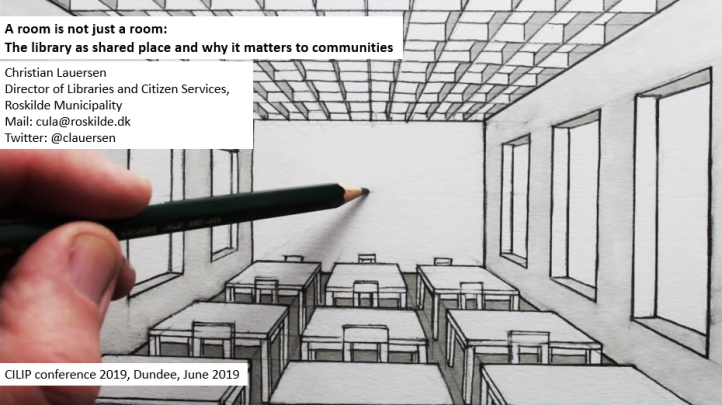
I like places. I especially like public places and when talking about the library as a shared public place I find two questions relevant;
First question is, “what makes a great place?” Try to think about a place that you were recently that just made you feel good and comfortable, that made you feel safe and welcomed.
Could be a lot of things; the light, the smells, sounds, the people, the decor, your feelings or perseption of a given institution, the values that institution or place represents to you etc.
It is a subjective feeling that defines what one finds a great place but I find it really useful, whenever I’m in a place where I really feel good, where I feel that I belong, to think about what it is about that place that make me feel like that. And then I start thinking that about how to take some of that and maybe transfer it into the library space. Chances are that I am not the only one who feel that way about that place.
Next question is, why do they always set the scene for interviews with academic experts in a library? I’m not sure if this is only a Danish thing or it is a global trend but I think they do it because they want to set a stage that connects with the person being interviewed, the ‘academic expert’. So why a library? Why not a university? First of all a library is often easy to spot. The book factor you know. A University as a place do not hold that significant placemakers as a library does. Then I think it also connects with some of the values that are connected to ‘A Library’. Trust for a start, they want the academic expect to be trustworthy. Knowledge and wisdom for a second – the books are great and powerful symbols of that and third, libraries are for everybody and it’s likely that they want the academic persons message to respond to everybody. I’m just guessing here but it is significant that interviews with academic experts are always staged in a library.
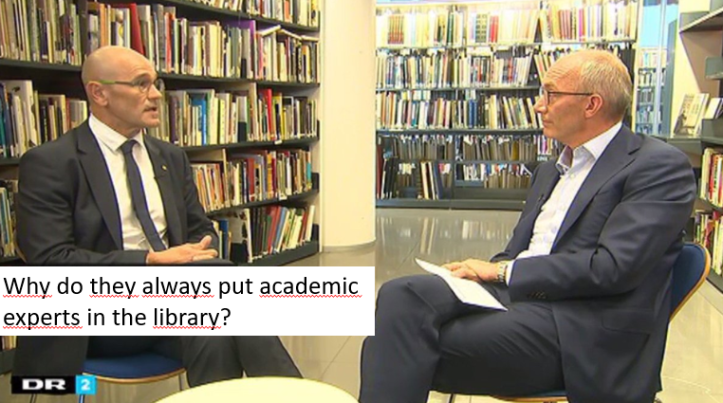
The reason why I’m asking these questions is that they both capture the essence of what this piece is about; Physical places matters to us and in a world with more digital ways to connect and communicate I think they matter more than ever. Creating great public and shared places for people to live, connect, belong and grow are essential for our communities to thrive and develop.
The library as a place is one of those significant shared places both because of what we do but also because of what we are.
This piece is gonna be about why public places matters, how to work with public places and to wrap it up, the library as a public shared place and why it is so important to communities. This will not be about library décor, library architrchture or library design.
Working with places is working with people
Working with places is working with people and communities. A building is not just a building to us and a room is not just a room. You need to understand people and understand communities to successfully work with the development of places. I’m not a psychologist, I’m just a library director but as a library director I’m in a people business and I often remind myself of Mashlow’s hearchy of needs when I work with developing libraries for people. Abraham Mashlow propose the hierarchy of needs in 1943. What his theory is suggesting is that humans are driven and motivated by different steps of needs in life. The first one is physiological, we need food and water and rest to function as human beings. It is basic and is proven by the general popularity of library cafes and coffees houses. A hierarchy of needs for students would 100% have coffee mentioned. The next one is safety: Could be the safety of our lives and health but also financial safety. The next one is really significant; We need love and belonging. We need family, friends, lovers – we need to sense that we are connected to something greater than ourselves. Many people become susceptible to loneliness, social anxiety, and clinical depression in the absence of love or belonging. This need for belonging may overcome the physiological and security needs, depending on the strength of the peer pressure. Then the need to feel respected by our surroundings and we need to have self-esteem and self-respect. Esteem presents the typical human desire to be accepted and valued by others. People often engage in a profession or hobby to gain recognition. These activities give the person a sense of contribution or value. The last level of need refers to what a person’s full potential is and the realization of that potential. Maslow describes this level as the desire to accomplish everything that one can, to become the most that one can be.

So how does this correspond with places?
It is a scientific fact that we respond to our surroundings and Marshlow’s needs is a pretty simple way to grasp what is going on when we respond to places. The physical environment can give us opportunities and limitations and it has the power to shape us and connect us and makes us thrive and make us sad or uncomfortable.
I like to give you two examples of the significant power of public and shared places.
My first example is personal. I love Berlin. I don’t have any formal connection with Berlin as a place; No relatives, no job etc. I just really love the city and as going back to the question what makes a great place? I tried to pin point why I love this city. One of the main factors is the huge amount of shared public places. Berlin has around 2.500 public parks and other green places and to me, those places works as connection points or gateways to the communities around the city. I like just to sit down and hang out in those areas that as shared spaces connects the community. They are always lively and the atmosphere is great and even though I’m not talking to anybody I fell that I am a part of something.
 Why I love Berlin – a picture I took hanging in a park last time i visited the city
Why I love Berlin – a picture I took hanging in a park last time i visited the city
The other story is research based and both horrifying and eye opening. In 1995 there was a deadly heat wave in Chicago and over 700 people died. A young graduate student of sociology named Eric Klinenberg decided to look into the demographics of the dead rates. The first thing he finds was oblivious; The more poor the area the higher the dead rates. But then he looked more closely on the numbers and he spotted something surprising; In some specific communities among the poor areas the dead rate was actually lower than in some of the richest parts of Chicago. He couldn’t crack that pattern just by looking at the numbers so he drived out to some of those areas and what he found was, that those areas all had a high number of shared public places like libraries, parks, athletic fields, grocery stores and so on and what he concluded was, that those place connected the community; Those shared places worked as a social glue for the community which meant that in a time of crisis the community were more able to be aware of who was sick, who was elderly, who would be more likely to stay inside which was a deadly thing to do in the heat wave, who didn’t show up for bride night at the library so we might better go check on them. Eric Klinenberg called this social infrastructure.
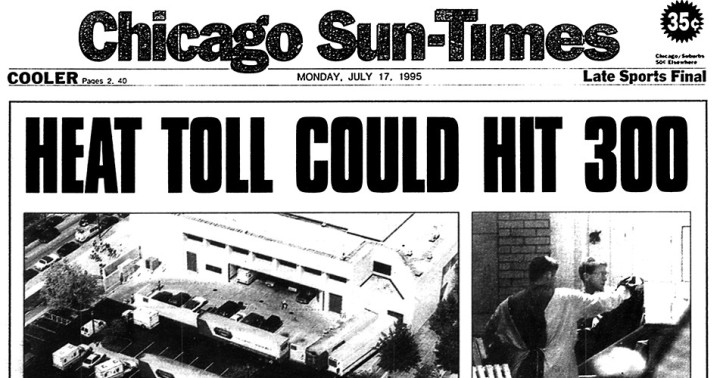
The library as social infrastructure: Not only shared books, also shared places
Where hard infrastructure in a community can be roads, houses, public transportation etc. social infrastructure are, according to Klinenberg ..spaces and organizations that shape the way people interact. When it’s robust, we are much more likely to engage one another and build relationships. When it’s degraded and neglected, we’re much more likely to hunker down and be on our own.
Social infrastructure is the glue that binds communities together, and it is just as real as the infrastructure for water, power, or communications, although it’s harder to see. If we neglect social infrastructure, we tend to grow more isolated, which can have serious consequences.
Eric Klinenberg argues that the library is one of the strongest elements in developing social infrastructure because it in its DNA is a shared community space. Libraries are not one-size fits all institutions but are shaping in response to their community – that being civic or academic. You don’t have to come there for a specific purpose. We don’t ask and we don’t judge. We are shared places with spaces, programs and resources to help people and to connect them and we have a pretty damn trustworthy brand. Library workers are not here to evaluate people and we don’t have any formal authority. We treat you the same way if you are poor or rich, if you get good or bad grades, we are here to help people to succeed with whatever they are doing.
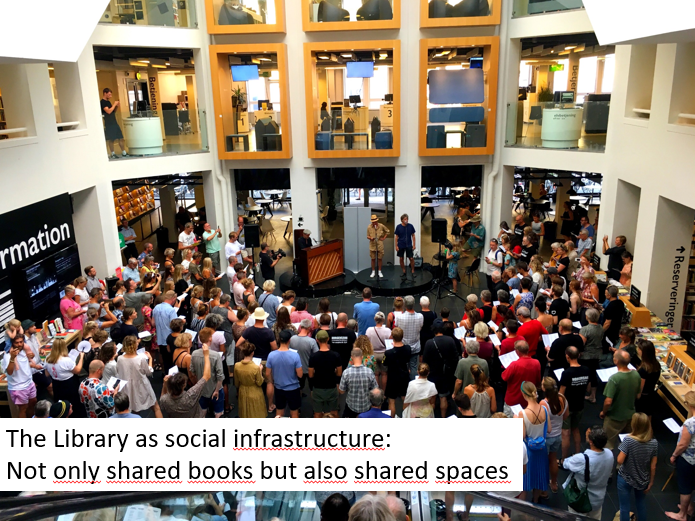
Community morning singing at Copenhagen Main Library
I strongly believe that public places such as libraries matters and are crucial to communities to connect, belong and thrive. Libraries are not only about shared books, they are also shared places for a community. Fewer shared places creates a weak social infrastructure and with that comes loneliness – the invisible cancer of communities. Isolation is bad of us. Really bad. According to multiple studies, lonely people are up to 50 percent more likely to die prematurely than those with healthy social relationships (check out the work of psychologist John Cacioppo). The heat wave in Chicago was a hard judge on lonely citizens. Great Britain got the world’s first Minister of Loneliness. Clean water and electricity are important for a healthy communities (Marslow’s first need) but so are share public community places (Marslow’s third need). Like Morrissey sang in the amazing The Smiths song How Soon Is Now from 1985 “I am human and I need to be loved just like anybody else does”. And we all know that The Smiths are right.
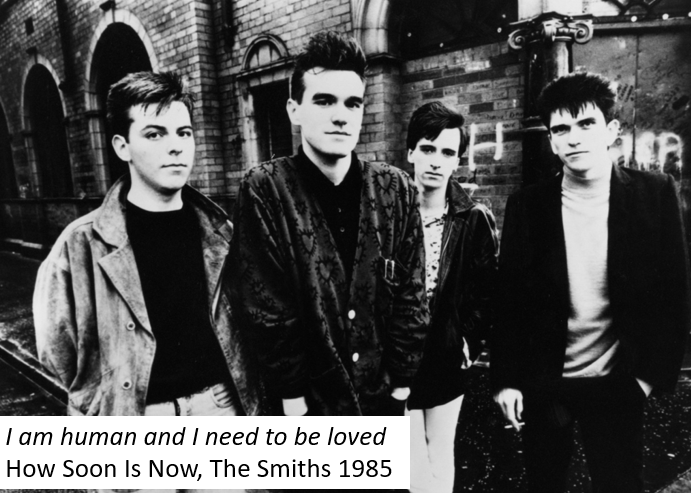
I’ll return to the concept of libraries as an important part of building a social infrastructure but first I like to introduce you to a great approach to working with the creation of public places called placemaking. Jan Gehl, Danish architect and urban designer, framed the philosophy of placemaking as first life, then spaces, then buildings. What Gehl means is that we should not do buildings for the sake of the buildings and just so people can have a place to stay – places are scaffolds of communities and lifes so we should start with that.
Placemaking: First life, then spaces, then buildings
Placemaking is a multi-faceted approach to the planning, design and management of public spaces. In short Placemaking is about Creating public spaces that promotes people’s health, happiness and well being. It could stand for itself but translated into a more specific library context a take on placemaking could be that the public library as a place is about Creating public spaces that promotes civic and academic communities ability to learn, explore, connect and belong
The art of placemaking is build on a handful of principles and here are some of them;
The community knows best: As Gehl pointed out we don’t create spaces and buildings for the spaces and buildings themselves. We do it for people. We do it for communities. But the people at the center of the place you are making, talk to them, listen to them, invite them into the process. Libraries are a people business.
Places not designs: When you are building a new library at a campus or in a community you should not only focus on the design of the library itselfs. You should take into account the relation to the landscape, the city, the buildings around it, other community parties and so on
Make and act on observations: By observing how a public space is used, it is possible to gain an understanding of what the community does and does not like about it. Be like the antropologist and go observe your community.
Requieres a vision: In order to succeed you need to have a vision of what you are aiming at when you work with placemaking. The vision should not reflect landmark architecture or a single person – the vision should reflect a community. What do your library wants to be to it’s community.
Placemaking is an ongoing process: You are never done placemaking. The community changes and the need for public places changes and even minor ongoing twerks to those changes can make a huge difference.
So to sum this up Placemaking points at, that when places work well, the serve as a stage for our public life. I like this picture because a stage to me is a place where you can express yourself, it’s place where you can go to new places, it’s a place where you can connect with people and if the stage should be effective to a community it should be accessible – it should be public and shared just like a library.

Placemaking used to develop a new main entrance at Roskilde Library to open the library up towards the city and create and extra open shared space in front of the library
So far:
- A place is not just a place. It effects us on a practical and emotional level and has the power to shape us, connect us and empower communities
- Loneliness kills
- Don’t start with the building. Start with the community
- Public places as libraries are important parts of our social infrastructure in civic and academic life
Why do they come? The library as place and brand
When I worked in academic libraries one of my fave things was to stand and look at a totally packed reading hall. It made sense to me, I thought it was important but then at some I time I started asking myself: “Why do they come?”. Why don’t they sit at home and study?”. Some of them for sure because they are gonna pick up a book or need library help or instruction and don’t get me wrong: I love a library filled with working students and I think we do an awesome job giving them good conditions but still, why do they come just to sit and work? Moving to public libraries I see the same patterne, lots of people coming to the library everyday just to be there. Drinks a cup of coffee and read the newspaper. Maybe just sit. I find the question important because I think it’s a window to both insights on the library and the people using them.
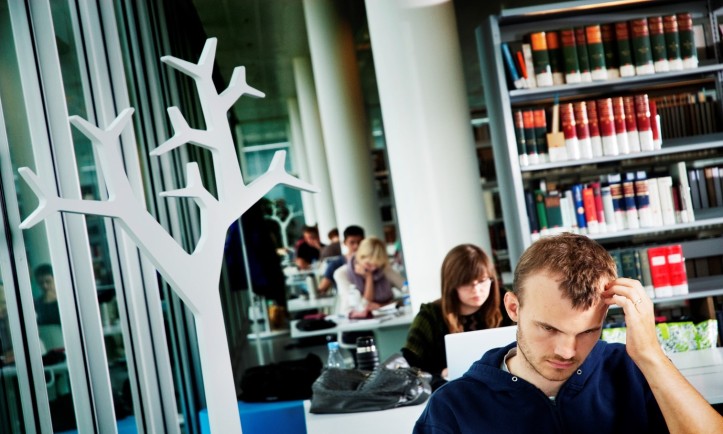
Non-scientific ase story: At my old workplace, the Faculty of Social Sciences at The University of Copenhagen we had two physical library sites: The Faculty Library and a smaller Study Library at the center of campus. The Study Library has a small reference desk that are staffed from 10 am to 3 pm on weekdays and 3 large reading halls which are open from 8 am to 10 pm which means, they are un-staffed every day for 9 hours. I meet with the provost at the faculty ones every month to deal with cases evolving the library. The provost often complained about the way the students treated campus; Trash everywhere, a trail of parties, broken stuff etc. For some reason we never experience this at the Study Library even if it was un-staffed many hours everyday. Why is that? Why do they trash campus but cherish the library? I think the answer to the question “Why do they come?” could be found in this pattern of behavior and I think it has to come with both the library as brand, development of the library as place and the life of the user.
I would argue that a part of the answer to why students flock to academic libraries to work has to be found in the library as a brand. In my whole professional carrier I have been hearing voices inside the profession who calls libraries and librarians ‘traditional’ and ‘dusty’ and is arguing that we need to re-shape the brand of libraries. I don’t mind taking a discussion about re-shaping the brand but what if the library in the head of the users are just what they need? Thinking about it, libraries has been around for almost 5000 years and has since the introduction of public libraries during the Enlightenment era been associated with spaces for learning, education, research and cultural activity.
Our values are openness, diversity, inclusion and accessibility (or at least that the values I like to be floating through my libraries). We are democratic institutions (but not neutral!). The book itself, which many link with libraries (for good reasons), are one of the strongest brands in the world. Looking at the example with The Study Library at Social Sciences I would not conclude that students love libraries but they for sure respect them.
Libraries don’t want people’s money – libraries want them to succeed, want them to learn, to explore, want to give them access to a bigger world and want them to connect and belong as a community. Libraries are extremely important parts of that social glue that binds a healthy society together.
In a highly capitalistic, polarized and digitized world, I think many people connects with that. So what if the brand og libraries is a bit traditional? It’s strong and it’s trustworthy and we should acknowledge that and use it in the future development of libraries – in general and as a shared community place. That is also why we should never change the name of The Library to something else – people understand what a library is and what it stands for, they don’t know that about a learning center, a learning common, a knowledge hub or a resilience center. Cherish the institution and the profession and be proud of it all – our communities needs it.
Final note; The library as shared place is important to communities but the place is only really meaningful when staffed with professional library workers – they are the most important part of any library
Cheers

Thank you for posting your speech, it would have been great to have been able to hear you. It’s interesting to hear from someone who’s worked in both academic & public libraries, & look at difference & similarities in attracting users. Cooperation & community sum up all libraries, it’s always good to get another perspective on how things work.
LikeLike
Great article! I totally agree with your final note. Professional library workers are the most important part of any library.
LikeLike
[…] https://christianlauersen.net/2019/06/03/a-room-is-not-just-a-room-the-library-as-shared-place/ […]
LikeLike
[…] Christian Lauersen: A room is not just a room: The Library as shared place and why it matters to communities […]
LikeLike
[…] Christian Lauersen: A room is not just a room: The Library as shared place and why it matters to communities […]
LikeLike
[…] A room is not just a room: The Library as shared place and why it matters to communities […]
LikeLike